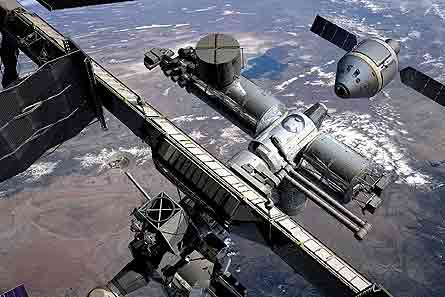NASA has selected Lockheed Martin to design and build, with an initial contract value of approximately $4 billion, the agency's Constellation programme's proposed four to six crew Orion spacecraft that will transport astronauts to the International Space Station (ISS) by 2014 and return them to the Moon by 2020. The Orion would carry six astronauts to the ISS and four to the Moon.
Lockheed’s primary subcontractors are the Boeing, Lockheed Space Shuttle ground operations joint venture United Space Alliance, Orbital Sciences, Honeywell Defense and Space Electronics Systems and Hamilton Sundstrand. In collaboration with Florida and Texas state government financial aid Lockheed had stated it would run the project from Houston, with large Orion structures and composites being built at NASA's Michoud Assembly Facility in New Orleans and final Orion assembly and checkout being done in Florida, where its launch site, Kennedy Space Center, is based.
In June 2005 Northrop and Lockheed were awarded $28 million each for eight month phase one contracts for concept refinement and requirements trade studies and analysis for Orion, then known as Crew Exploration Vehicle. Just prior to that, in May, NASA administrator Michael Griffin set up his 12-week Exploration Systems Architecture Study (ESAS) to assess the requirements for accelerating development of Orion and its launch vehicle to provide crew transport to the ISS earlier than 2014.
|
|
|---|
| Above: Orion's first mission will be International Space Station crew transport |
On 19 September NASA released the results of the ESAS. It had selected an Apollo programme style crew capsule and Apollo mission architecture for its return to the Moon. The launch vehicles would be the recently renamed Ares I, for Orion, and, for the Earth departure stage and Constellation's version of the lunar lander, the heavy lift Ares V. The phase one work was extended with a Call For Improvements (CFI) in December of that year.
This was to enable the bidders to incorporate the ESAS study into their proposals. The proposals from the phase one studies and the CFI were to be submitted in March 2006. Then additional work, due to NASA’s decision in the first quarter of this year to reduce the Orion’s outer mould diameter from 5.5m (18ft) to 5m, saw a second submission deadline in April. NASA has been in ongoing contact with the two bidders since April as it has worked towards its final award decision.
|
|
|---|
| Above: The Ares I launcher will place the Orion into a suborbital trajectory |
NASA announced in March that its Lockheed managed Michoud Assembly Facility in Louisiana would manufacture the Ares I upper stage and the Ares V’s Earth departure stage.
Ares I will take about 10min to launch the Orion with its first stage separation after 131s at 195,600ft and the upper stage engine firing at 133s and burning for 463s. During this second stage boost period Orion’s launch abort system is ejected.
Source: FlightGlobal.com

























